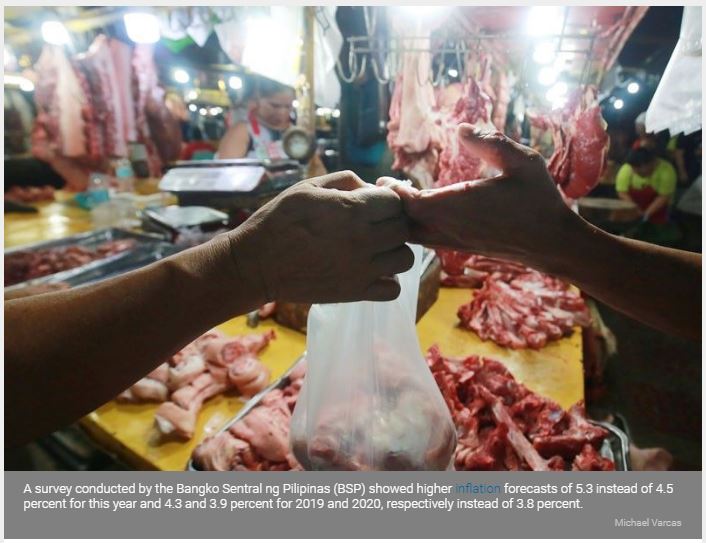Philippines: Economists see higher inflation rates
MANILA, Philippines — Economists of private banks raised anew their inflation forecasts over the next three years amid rising global oil prices, higher food prices, a weak peso, and the effects of the implementation of the tax reform program.
A survey conducted by the Bangko Sentral ng Pilipinas (BSP) showed higher inflation forecasts of 5.3 instead of 4.5 percent for this year and 4.3 and 3.9 percent for 2019 and 2020, respectively instead of 3.8 percent.
“Analysts noted that risks to inflation in 2018 remain tilted to the upside, with possible risks coming from various factors including higher and volatile global oil prices, higher utility rates, rise in wages and transport fares and higher inflation expectations,” the BSP said.
The survey covering 28 respondents was conducted from Sept. 6 to 14.
Bank of China has the highest inflation forecasts at seven percent for 2018, 5.5 percent in 2019, and five percent in 2020.
Korea Exchange Bank sees inflation averaging 5.7 percent this year followed by Ayala-led Bank of the Philippine Islands (BPI) with 5.6 percent, Al Amanah Islamic Bank (5.5 percent), UBS (5.4 percent ), and CTBC Bank, Robinsons Bank, and Philippine Equity Partners (5.3 percent).
Deutsche Bank has the lowest inflation forecast of 4.8 percent for 2018.
Economists also cited the impact of the implementation of Republic Act 10963 or the Tax Reform for Acceleration and Inclusion (TRAIN) Law on the prices of domestic goods, the rise in the prices of food and other commodities due to adverse weather conditions and supply shortage, higher utility rates as well as rise in wages and transport fares, strong domestic demand during the holiday season.
Other upside risks include the delay in the implementation of the government’s mitigating measures against rising inflation, higher government spending on infrastructure as well as the trade war between the US and China.
However, analysts noted there are downside risks to inflation emanating from fiscal policy actions or mitigating measures such as the rice tariffication, Pantawid Pasada program, unconditional cash transfers, and slower global growth.
Inflation leapt to a near-decade high of 6.7 percent in September from 6.4 percent in August. The consumer price index (CPI) averaged five percent in the first nine months,exceeding the BSP’s two to four percent target.
This prompted the BSP’s Monetary Board to raise interest rates by 150 basis points so far this year to keep inflation expectations well anchored.
Economists expects inflation to moderate in 2019 and 2020 as the impact of TRAIN tapers off, global oil prices stabilize, and the government implements mitigating measures to temper inflation.
However, analysts are also watchful of potential inflationary pressures from a possible reserve requirement ratio (RRR) reduction and the implementation of Package 2 of the TRAIN Law.
Based on the probability distribution of the forecasts provided by 24 out of 28 respondents, there is a 0.5 percent probability that average inflation for 2018 would settle between the two to four percent target range, while there was a 99.5 percent chance that inflation would exceed the target.
For 2019, the respondents assigned a 30.2 percent probability that inflation would fall within the target and 69.5 percent chance that inflation would breach the upper end of the target.
Source: https://www.philstar.com/business/2018/10/22/1861986/economists-see-higher-inflation-rates#JW6iErxSFTVXLoyC.99


 Thailand
Thailand




